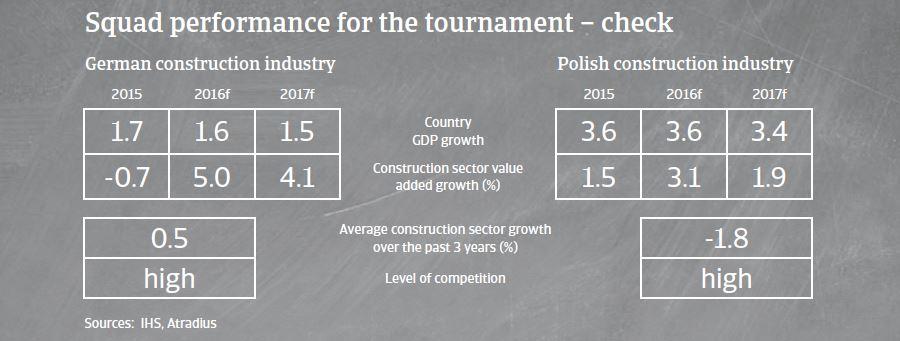In Germany, poor payment behaviour of public buyers is an issue, while in Poland protracted payments are high. Overdue payments up to 30 days are common.
European football championship 2016
Sector playing field: construction industry

Germany: a strong rebound after bad performance in the past
Just like the German national football team construction suffered a major crisis in the late 1990s and early 2000s, but has bounced back since then, becoming increasingly successful. According to the German Builders Association, turnover growth will increase 3% in 2016, to EUR 103 billion.
Poland: the last European championship was a watershed
Polish construction activity was strong ahead of the last 2012 EURO in Poland and the Ukraine, especially in infrastructure building. But just like the Polish football team failed to reach the Round of 16, the construction industry saw a serious deterioration of production since H2 of 2012, as major projects had been completed and many contracts turned out to be unprofitable as material prices increased. Construction insolvencies increased by more than 50% in 2012 and remained very high in 2013. However the sector rebounded in the course of 2014 and registered a production growth of 2.8% in 2015.
Players to watch
Germany

Residential construction is expected to increase 5% in 2016, driven by a high employment rate, low interest rates and the need to provide new housing for the high number of refugees and asylum seekers.
Poland

Residential construction production value increased 9% in 2015 and is expected to grow further in 2016, driven by the robust economic performance in Poland.

In the public construction segment demand is expected to increase in 2016 and beyond, but low prices are serious issue for building businesses.
Major strengths and weaknesses

German construction industry: strengths

Polish construction industry: strengths
- Increasing demand and stable profit margins expected in 2016
- In general, businesses are not highly indebted
- Construction businesses´ dependence on bank finance is not overly high, given that in advance or instalment payments by investors are a major source of financing.
- Significant amount of specialization, especially in construction service
- Strong in technical innovations especially in the area of energy-efficiency
- Robust economic performance, low interest rates and positive investor sentiment
- EU funds for infrastructure improvement
- Decreased steel and oil prices have a positive impact on businesses profits since 2015

German construction industry: weaknesses

Polish construction industry: weaknesses
- Very high number of small companies active in this sector
- Limited access to international capital markets
- Many construction companies – especially smaller ones – traditionally have weak equity ratios (the proportion of equity used to finance a company's assets) and limited financial scope.
- Many Polish construction businesses are highly indebted, mainly to suppliers, not banks. Banks sharply decreased their engagement in the construction sector after the 2012 building slowdown.
- However competition is high, especially for public infrastructure tenders: winning tender prices are usually far below investor budget, with price wars on-going
- Low prices accepted for winning public tenders often mean that general contractors transfer costs to subcontractors
Fair play ranking: payment behaviour and insolvencies
German construction industry
On average, payments in the German construction sector take around 45-50 days.
Instances of payment default decreased again in 2015, and this positive trend is expected to continue in 2016.
However, the poor payment behaviour of public buyers still remains an issue, as it puts a strain on suppliers’ liquidity.
Among increasing demand and stable profit margins construction insolvencies have decreased in recent years and are expected to decline further in 2016
However, the proportion of insolvencies in the construction sector is traditionally higher than in other industries.
Polish construction industry
On average, payments in the Polish construction sector take 75 days.
Payment behaviour has been bad over the past two years, and the number and amount of protracted payments remains high.
General contractors often transfer costs to subcontractors by delaying payments. Overdue payments of up to 30 days are quite common
In March 2016 the National Debt Register recorded construction companies debts amounted Polish zloty 1.35 billion. – an increase of Polish zloty 320 million since September 2015.
Insolvencies are expected to remain on a high level in 2016.

